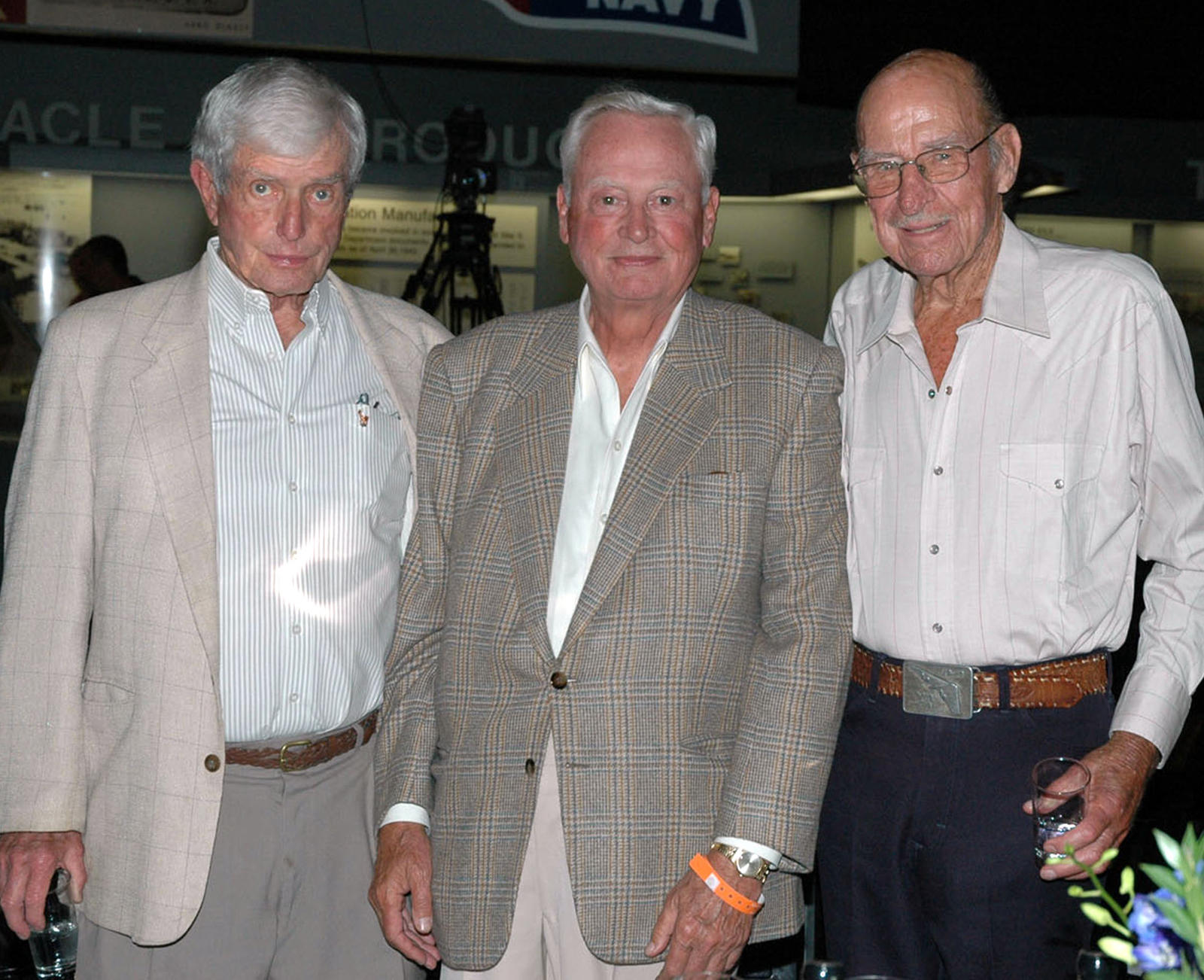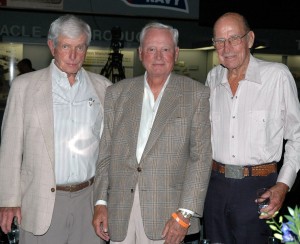
During the 2006 Young Eagles gala, David Tallichet (left) shared a table with good friends Barron Hilton (center) and John Myers, retired Northrop and Lockheed test pilot.
By Clayton Moore
David Tallichet accumulated enormous wealth by building aviation-themed restaurants, but despite what he called their “Disneyland appeal,” the entrepreneur never lost his love for real airplanes. His vivid memories of flying in World War II as a bomber pilot drove him to his real passion—collecting the warbirds and bombers that he remembered from his military flying days.
Tallichet passed away at his home in Orange County, Calif., on Oct. 31, after a struggle with prostate cancer. He was 84 years old.
His son, John Tallichet, told the South Bay Daily Breeze, “He’d say he got a slow start, but once he got going he made up for it.”
David Compton Tallichet Jr. was born Dec. 20, 1922, in Dallas, to David and Margaret Tallichet. After completing high school, he studied at the University of the South, the University of Texas and Southern Methodist University.
As America was plunged into World War II, the young man joined the U.S. Army Air Forces, with which he remained on active reserve status until 1957.
The war years
Emboldened by his passion for aviation, Tallichet eagerly completed primary, basic and advanced flight training before reaching the pinnacle of his military career: flying the four-engine Boeing B-17 Flying Fortress. It was an aircraft that he recalled fondly his entire life, and one that he would eventually own. In 1998, he declared that the B-17 was “a living symbol of American courage and sacrifice.”
After completing his B-17 training, Tallichet’s next assignment was to a crew that flew a B-17 from the United States to the United Kingdom, which was embroiled in its own aerial battles with the German Luftwaffe. Tallichet flew as copilot to 2nd Lt. Milton Alvo, along with a nine-member crew that coalesced into a cohesive combat unit. The team became part of the 350th Bombardment Squadron, which joined the 100th Bomb Group, based at Thorpe Abbot, in February 1945.
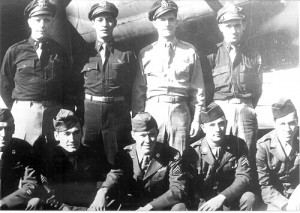
The crew of the Spirit of Pittwood, standing, L to R: Walter Gibson Jr., Milton Alvo, David Tallichet and Donald Israel. Kneeling, L to R: George Murray, Boleslaw Bitel, Farrell Davis, Woodrow Wilson and Leonard Woodruff.
From there, Tallichet and his crew flew 20 missions into the heart of the Nazi war machine, striking targets in Hanover, Frankfort and other critical sites in Germany, most of them conducted in a resilient B-17 named Spirit of Pittwood. Tallichet also flew on two more missions with other crews. By May 1945, Germany was defeated and victory in Europe declared. Later, he flew transport aircraft on missions supporting the rebuilding of the war-torn continent.
A keen eye for business
Returning home, Tallichet began working for Hilton Hotels in a number of different positions while simultaneously serving in the New Mexico Air National Guard. His continuing military service afforded him the opportunity to fly the P-51 Mustang.
In 1955, he accepted a position as general manager of the Lafayette Hotel, owned by Conrad Hilton, in Long Beach, Calif. The job gave him another unique opportunity when the hotel hosted the Miss Universe Pageant. Tallichet would go on to marry the candidate from Indiana, who became Tallichet’s first wife and the mother of his four children.
Now that he had gained some experience in the hospitality industry, Tallichet returned to a business notion he thought might be successful. Several years before, he had visited a remote restaurant in the Midwest that drew large crowds because of its country theme. In an age before chains took such a hold on the country, the idea was innovative. In 1958, Tallichet and two partners, one of them Sea World founder George Millay, opened the Polynesian-themed Reef Restaurant on the waterfront in Long Beach.
It was the launching point for Tallichet’s Specialty Restaurants Corporation, an entity now managed by his son, John Tallichet. Soon after opening the Reef Restaurant, he launched Ports O’Call in San Pedro, Calif. The company, credited as a pioneer in the restaurant industry, was responsible for launching more than 100 ventures.
Tallichet’s locations included aviation-themed restaurants like the 94th Aero Squadron, first opened in Denver in 1965, which drew visitors into World War I with on-site replica aircraft and an interior resembling a French farmhouse. The Proud Bird is located next to a runway at Los Angeles International Airport (LAX); historic aviation photos line the interior. More aviation-themed eateries pay tribute to the 56th Fighter Group, the 391st Bomb Group and the 101st Airborne.
Other restaurants included the Cajun-themed Crawdaddy’s and Baby Doe’s Matchless Mine. Two-hour waits and millions of dollars in sales testified to the merits of Tallichet’s risky concepts.
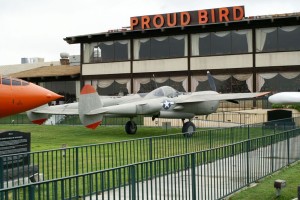
The Proud Bird Restaurant at Los Angeles International Airport features dozens of replica aircraft created by David Tallichet’s Military Aircraft Restoration Company.
The company specializes in what Tallichet called the “Disneyland effect,” utilizing fictional histories and themed décor to capture visitors’ imaginations. SRC also traditionally chose dramatic geographic locations, positioning restaurants adjacent to airport runways or on visually dramatic vistas. John Tallichet recalled that his father even contemplated opening an aviation theme park.
“My dad was a creative thinker,” he said. “He always saw things differently. He was always excited about the next deal.”
Today, the Anaheim-based company operates just 25 restaurants in nine states, although the Reef had its best year in its history this year, and SRC has recently expanded into catering.
The collection of a lifetime
In the early 1960s, Tallichet found time to visit the National Air Museum at the Smithsonian in Washington, D.C. Spending time among the aircraft he cherished inspired him to go into the airplane restoration business. He bought a P-51 Mustang for $13,000. It was the first plane in an ultimately breathtaking collection of aircraft, one that was, at one time, the largest collection of privately owned and flying World War II aircraft.
To manage his collection, Tallichet founded the Military Aircraft Restoration Company under the legal umbrella of SRC. He bought large numbers of aircraft, including B-25 Mitchell bombers, Korean-era MiG jets, P-40 Tomahawk fighters and enormous B-29 bombers.
The pursuit of his collection, which at one point numbered 120, could be quite adventurous at times. In the 1970s, Tallichet and friend Ed Jurist discovered that the Iraqi Air Force still had three dozen Sea Furies and huge quantities of spare parts, so they struck a deal to bring the planes home. He journeyed into the jungles of New Guinea to hunt down wrecks, ventured to Libya to bargain over military planes and carried aircraft parts out of the Canadian Rockies. He sometimes dismissed his hobby as unwise because of the significant expense involved, but his business acumen usually balanced the books.
“He loved the art of negotiation,” said John Tallichet. “So, while there was the adventure of flying, there’s also a lot of horse trading that goes on with these old planes, and he loved that.”
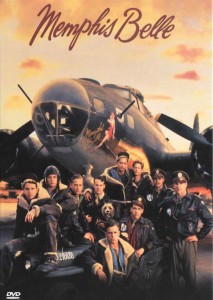
In 1989, David Tallichet flew his restored B-17 bomber to England, where it was featured in the title role of the movie, “Memphis Belle.”
Eventually, the Military Aircraft Restoration Company branched out into the movie business. Tallichet produced many of the Corsairs seen in the television program, “Black Sheep Squadron”; more recent films like “Pearl Harbor” and “Collateral Damage” used the company’s replicas. During his heyday, Tallichet owned more than 100 aircraft, but began selling off the aircraft in recent years.
His most famous accomplishment may have been his acquisition of a B-17G fire bomber, eventually converted into a B-17F for its starring movie role. In 1989, Tallichet piloted his bomber across the North Atlantic so it would appear in the title role of the movie, “Memphis Belle.” The film, starring Matthew Modine, portrays the 25th mission of the titular bomber. Not only did Tallichet donate his bomber to the film’s cause, he also joined the production as a pilot. Its director stressed the complexity of the production to the New York Times.
“It was a bit like trying to make ‘Ben Hur’ with three horses, one of them rather old and sleepy,” said Michael Caton-Jones.
In July, Tallichet piloted the aircraft to a Michigan air show, which honored him as the last World War II combat pilot still flying the extraordinary aircraft.
“There is no other person in the country who is so singularly responsible for the preservation of these aircraft,” Gary Lewi of the American Airpower Museum said. “He saved the aircraft for another generation but he also used them to pay tribute to those who flew them.”
In addition to his wife, Carol, and son John of Newport Beach, Tallichet is survived by a daughter, Catherine Ann of Jackson Hole, Wyo.; two other sons, William of San Pedro and James of Jackson Hole; and four grandchildren.











